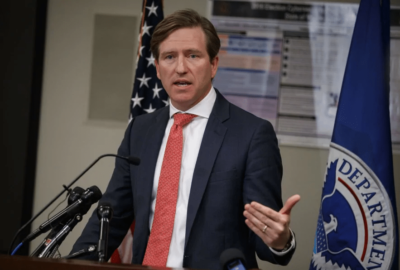

As technical director of DISA’s Infrastructure Directorate, Bryon Doyle said his job is to have an oversight of the organization’s architecture.
The Defense Information Systems Agency is on the forefront of federal network development and is considering how Software Defined Wide Area Networking (SD-WAN) can help it provide network capabilities across the Defense establishment.
As technical director of DISA’s Infrastructure Directorate Bryon Doyle said, his job is to have an oversight of the organization’s architecture. That means outreach to both vendors and customers to see how services, Defense Department agencies and other federal partners can best use the environment.
Doyle said DISA started with legacy technologies but as it modernizes into the future, the agency wants to mimic the commercial environment in terms of capacity, routing optimization and other core functions.
“So as we get capacity, there’s demand, right? Demand’s never going to go away,” Doyle said on Federal Monthly Insights – Network Modernization and SD-WAN. Core technologies and fiber optic transmission are helpful in this area, he said. “There’s a notion on availability, right? So we want to make sure we’re super available. If we’re doing things like cloud computing, where the network is tethered, we become incredibly critical to the cloud environment.”
Cybersecurity is absolutely critical, he said. That means an emphasis on supply chain risk management and security of the internal backbone, as well as on customer connections. The challenge comes when the act of putting all those pieces together “exceeds what people can do on the keyboard.”
“So in the past, folks would type commands into routers or optical switches or telephone switches. But in this converged environment, we really can’t do that without a helper systems, right?” Doyle said on Federal Drive with Tom Temin. “And those helper systems are in the form of automation capacity – capacity management, your service orchestration – being able to provision capacity right away and then also being able to maneuver our infrastructure, which kind of sets the stage for software defined networking, software defined wide area networks that help us to better improve ultimately our user experience, which is a commitment to our warfighting customers.”
That then can improve the way DISA behaves as a carrier to deliver things at cost. Doyle said the agency has a financial responsibility and that’s where the market helps with competition and engagement. That obligation to financial responsibility means asking for current technologies, rather than older versions, and scaling linearly.
DISA has several roles which Doyle outlined. The agency provides telecom services to the military, it’s an enterprise services provider for on-duty personnel, and it’s also a “last mile connective tissue” between DoD and commercial cloud partners.
“So because of that, there’s not a cut-and-dry, just – take this playbook and do it. We have to assemble our strategy from those different sort of personas or dimensions to what we do,” he said. “So there’s a lot of vendor outreach. There’s a ton of engagement where we want to understand what our industry partners are doing.”
He said network planning follows a structured process of mathematical analysis and forecasting, or qualitative network analysis.
Looking ahead, many organizations are considering SD-WAN, and DISA is no different. Counting up the number of sites and users is not something one can do in a spreadsheet. Certain transactions do not follow a traditional multiprotocol label switching network.
From a technical perspective, SD-WAN may not be as useful as it could be on the enterprise side, Doyle said.
“Where SD-WAN is incredibly powerful for us, it allows us to shift the traffic where, if we’re going to cloud centers and moving – different types of flows around,” he said. “Ultimately one of the other things about SD-WAN that’s very interesting is it can transport media agnostics, so that means it can run on optical, internet cell sites. Those are a lot of the corporate use cases.”
Copyright © 2024 Federal News Network. All rights reserved. This website is not intended for users located within the European Economic Area.
Amelia Brust is a digital editor at Federal News Network.
Follow @abrustWFED


